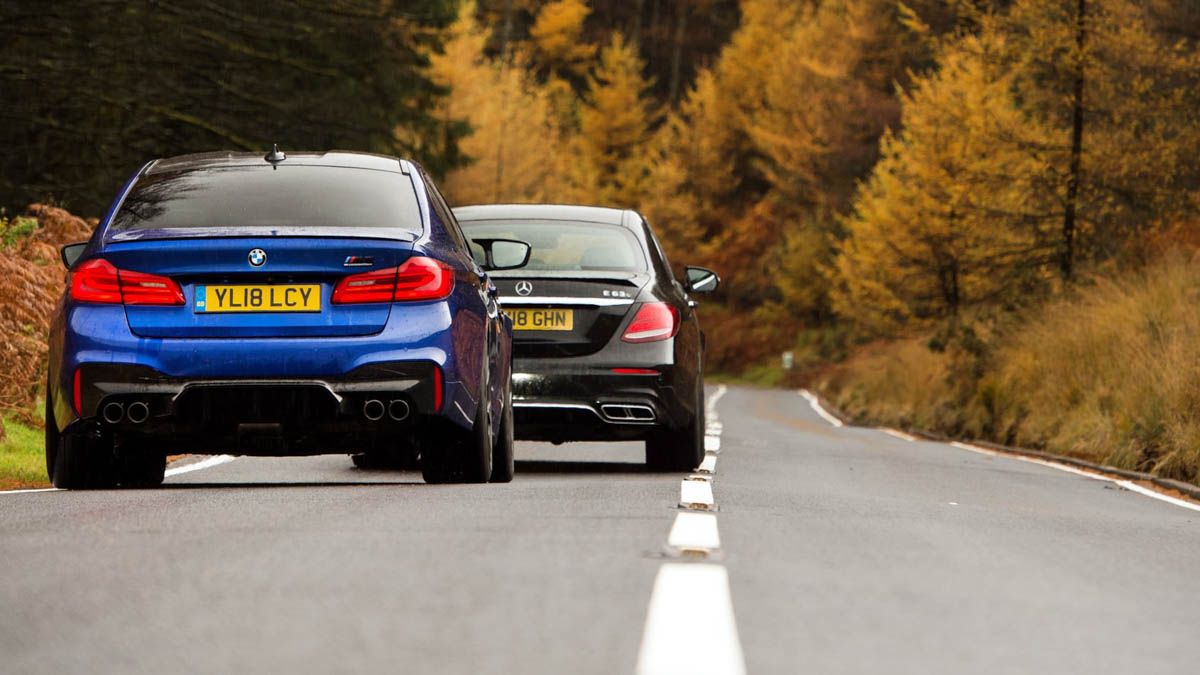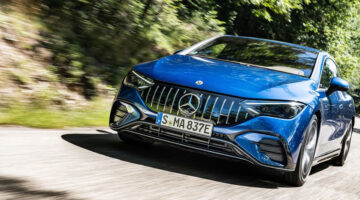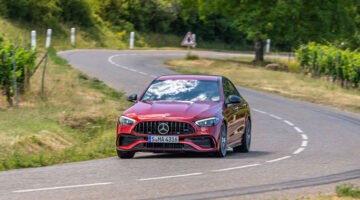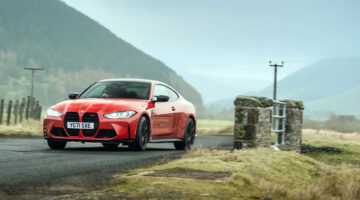The BMW M5 Competition and Mercedes-AMG E63 S both boast more than 600bhp, 0-100 times in the threes, and massive road presence. Which begs the questions: can you have too much of a good thing?
When does a supersaloon cease to be a supersaloon? When does it outgrow its genre and become something altogether more serious? Just as some supercars and hot hatches have created the subgenres of hypercar and hyperhatch respectively, so too certain supersaloons have evolved to create the hypersaloon: witness BMW’s M5 Competition and Mercedes-AMG’s E63 S.
Mustering more than 1200bhp between them, these ultimate expressions of what a four-door saloon is capable of will arrive at 100kph in as near as dammit three seconds and, if the electronic safety net was packed away, romp to 305kph. No matter the irrelevance of those numbers, it’s hard not to be impressed by the results. These are the go-faster four-doors that go faster than most.
These are also the pinnacle of BMW’s and AMG’s achievements for models that can also be bought with 2-litre turbodiesel engines. The M5 Competition is an upgrade of the regular M5, a car few have walked away from disappointed. Still, BMW M found more power from its twin-turbo V8 – a 24bhp increase – to raise the peak to 616bhp (torque still summits at 553lb ft), and discovered it could carry out more work to its chassis. It rides 7mm lower, the springs are ten per cent stiffer, the adaptive dampers recalibrated and the anti-roll bar mounts firmer. They even threw in ball joints for the rear toe links, dialled in greater negative camber on the front wheels and increased engine mount stiffness by 50 per cent, all in the name of sharpening the M5’s edge.
AMG, meanwhile, has always offered the E63 in both standard and more powerful S specifications. Even so, the 63 S gives away 12bhp in the horsepower race – ‘just’ the 604bhp from its hot-V 4-litre – while at 1880kg it also concedes a few kilos to the 1865kg BMW.
However, the M5 might want to turn a blind eye to the E63 S’s 627lb ft of torque, fed through a nine-speed auto compared with the M5’s eight. And it’s not only the outputs that differentiate the 63 S from its lesser-powered sibling, its chassis has had a similar amount of lowering, stiffening and sharpening carried out as the BMW. This pair also feature a technical element that has previously been the domain of rival Audi: four-wheel drive. Whether called 4Matic or xDrive, both systems are adaptive depending on available traction, and both can be switched to rear-wheel drive only. More on this later.
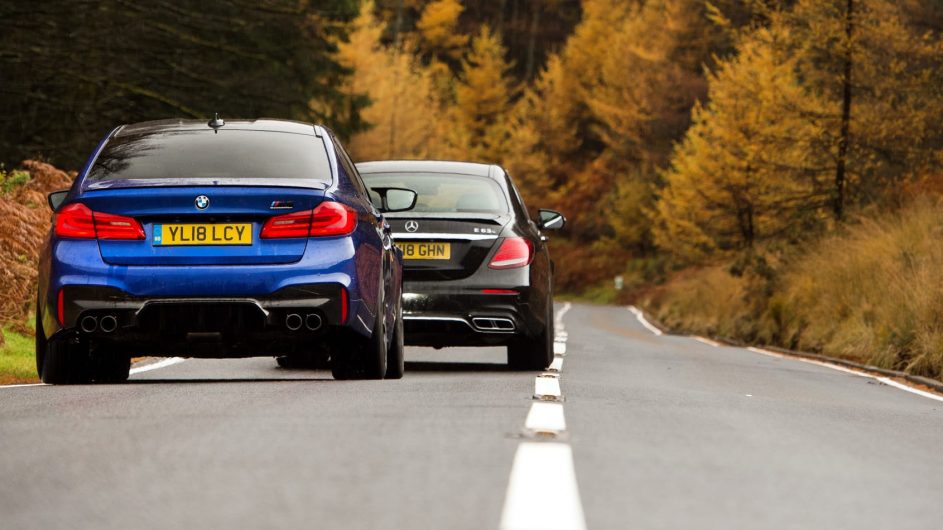
Despite its similarity in specification to the E63 S, it’s quickly apparent the M5 Competition treads its own path. Where the AMG fires with an ostentatious flare and crackle of revs, the M-car is more subdued and sophisticated – a characteristic it maintains on the move. Even with its standard sports exhaust at its rudest, the BMW rarely gets shouty, emitting a distant baritone roar as you work the V8 harder. If anything it sounds a little synthetic; a digitally developed version of what engineers think a bent-eight should sound like.
There’s no attempt by the Mercedes to curb its noise pollution: it bellows, burps, snaps and crackles away in response to every single throttle action. It’s fast, too. That bottomless pit of torque is always on call, working in unison with a level of traction that is hard to compute given the numbers the engine musters, no matter what the number of wheels managing the load. Climb through the driver modes and at its peak the throttle response is GT R sharp and precise, exhibiting not the slightest hint of turbo lag. As a replacement to AMG’s wondrous naturally aspirated V8s, this twin-turbo unit is worthy of the badge it carries.
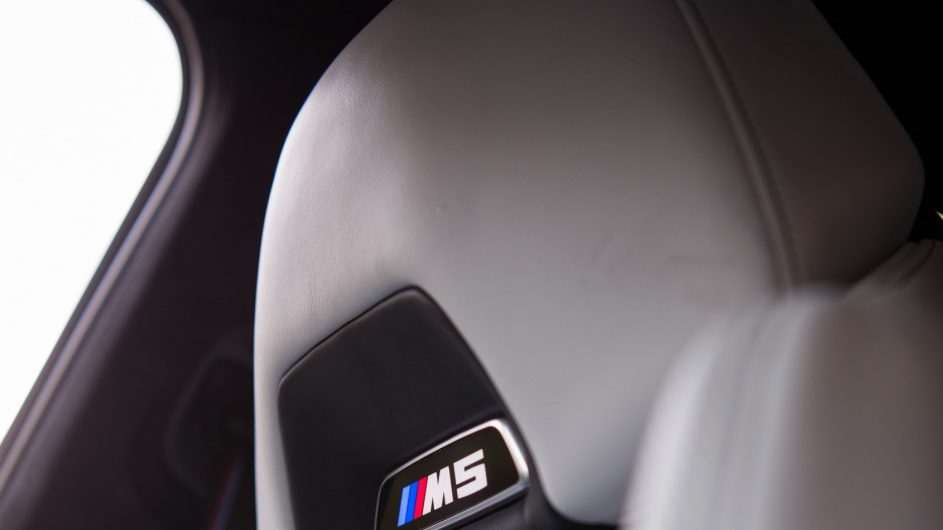
After the E63 S, the BMW feels less savage. Yes, that does sound ridiculous for a car that has a power output that bests a Zonda F and, make no mistake, is every bit as quick as the AMG, devouring straights with such breathtaking violence that a Ferrari 488 GTB would be sweating. But there’s a softness to its longer-travel throttle pedal and greater refinement that saps some of the speed sensation. It’s a feeling that’s compounded by the rest of the M5’s dynamics, which tread a neat line between go-for-it and grown-up. The Competition’s more focused suspension settings result in a firmer ride, but it’s quieter and works the surface with greater fluidity than the occasionally brittle AMG. There’s a touch less connection and feel through the steering, too, but the rack is quick and precise and there’s enough chatter to let you know there’s bags of turn-in bite. It also reacts slightly faster than the ‘normal’ version, those chassis changes shaking out the last tiny vestiges of slackness: it’s taut and honed like the best M-cars of old.
Both cars allow you to configure their engine, gearbox, chassis and traction settings to suit, offering direct access to your favourite combination(s) via M (BMW) or Individual (AMG) modes – engaged via a pair of wheel-mounted buttons for the former, or a roller-switch on the centre console for the latter. If you want the full rear-drive, traction-off experience, however, you’ll need to dive deeper into the systems.
You never escape the M5’s sense of scale and you need your wits about you when it starts to sidestep, particularly when it’s wet. You’re always aware that the car’s extremities are far, far away and that it doesn’t require much to find yourself taking up all of your side of the road, and more besides. Much more. You have to be equally wary in the Mercedes, but its sharper throttle and more cocooned driving environment mean it feels a fraction more manageable, as if you’re part of the machine. It generally feels more connected, thanks to its grittier steering feel, more focused ride and, yes, its more evocative soundtrack – it wears its AMG heart proudly on its sleeve.
Ostensibly the M5 Competition is a more complete and polished performer. It’s the quiet one, but its rivers run deep. By contrast, the Mercedes is more honest in what it’s been engineered to be, its secrets given up earlier, to be enjoyed more of the time. Yet arguably both are too big and too heavy for their performance potential to be fully enjoyed. But the existence of this new breed, the hypersaloon, should be celebrated as much as its predecessors continue to be. And if you still yearn for a new car that fits the traditional supersaloon mantra, you can always look towards both of these cars’ smaller, lighter and more focused siblings.
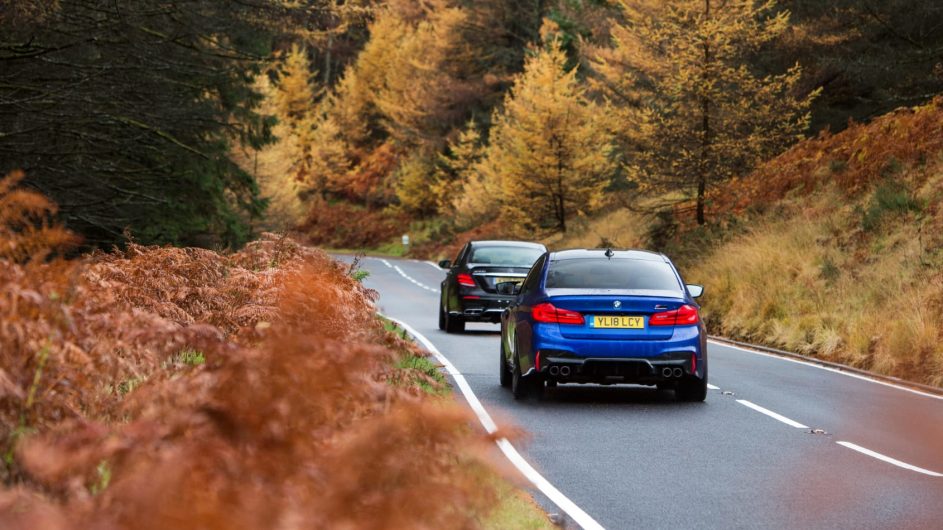
| BMW | M5 Competition |
|---|---|
| Engine: | V8, 4395cc, twin-turbo |
| Power: | 616bhp @ 6000-6700rpm |
| Torque: | 553lb ft @ 1800-5800rpm |
| Weight: | 1865kg |
| Power-to-weight: | 336bhp per ton |
| 0-100kph: | 3.3sec |
| Top speed: | 250kph (limited) |
| Basic Price: | $124,630 |
| Mercedes | AMG E63 S |
|---|---|
| Engine: | V8, 3982cc, twin-turbo |
| Power: | 604bhp @ 5750-6500rpm |
| Torque: | 627lb ft @ 2500-4500rpm |
| Weight: | 1880kg |
| Power-to-weight: | 326bhp per ton |
| 0-100kph: | 3.4sec |
| Top speed: | 250kph (limited) |
| Basic Price: | $122,715 |
This article originally appeared at evo.co.uk
Copyright © evo UK, Dennis Publishing

